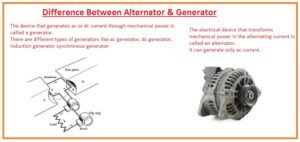 Hello, friends, I hope you all are doing great. In today’s tutorial, we will discuss the Difference Between Alternator & Generator. The basic difference between alternator and generator is that in alternator armature is in rest position and field windings move while in generator it is reverse field is static and armature moves. In the alternator the armature windings is wounded at the static component of the alternator that is stator and field winding is wound on the rotor.
Hello, friends, I hope you all are doing great. In today’s tutorial, we will discuss the Difference Between Alternator & Generator. The basic difference between alternator and generator is that in alternator armature is in rest position and field windings move while in generator it is reverse field is static and armature moves. In the alternator the armature windings is wounded at the static component of the alternator that is stator and field winding is wound on the rotor.
But in case of a generator, it is reverse armature is at rotor and field winding is at the stator. The working operation of both alternator and generator is based on Faraday’s law. In generate ac and dc both currents can be generated mean generator can be either ac or dc but alternator produces only ac current. The rotating part or rotor of a generator is positioned in the static part of the generator or static magnetic field that is generated by the magnetic poles. Due to rotation of the rotor in the magnetic field, it links with a line of force of field and current flows in it. Each half rotation the rotation direction of rotor varies and it generates ac current. To get ac current the endpoint of circuitry is directly attached to the load. If dc has to get at output terminals than commutators are attached that transform ac into dc. In today’s post, we will have a detailed look at both alternators and generators and compare them to find their differences. So let’s get started with Difference Between Alternator & Generator.
Difference Between Alternator & Generator
Alternator
- The electrical device that transforms mechanical power in the alternating current is called an alternator.
- It can generate only ac current.
- In an alternator, a rotating magnetic field is generated.
- The output of an alternator is taken from the stator.
- There is rotary armature is used in some types of alternators
- The generator can become an alternator with some changes in the structure
- There is permanent magnet is used for field creation.
- Such an alternator that runs a steam turbine known as a turbine alternate.
- Three phases alternators use fifty Hetz frequencies for power generation.
Generator
- The device that generates ac or dc current through mechanical power is called a generator.
- There are different types of generators like ac generator, dc generator, induction generator synchronous generator
- This device can produce both ac and dc currents.
- It generated a static magnetic field.
- It uses the Faraday law of electromagnetic induction to generate powr.
- Three-phase generators used in a generation to deliver power to the system.
- Its main parts are winding, rotor, stator, and shaft
- Its output can be taken out from the rotor.
- Its armature is not static.
- Its revolution per minute is less than the alternator.
- It can charge the battery contrary to the alternator.
- Its generated output is less than the alternator.
That is a detailed post about difference between alternator and generator if you have any further query ask in comments. Thanks for reading. Have a good day. See you in the next interesting tutorial.






